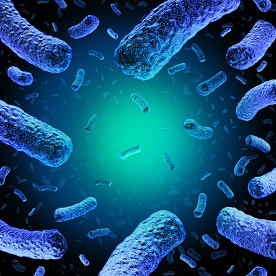Currently Empty: ₹0.00
Food Safety: A Microbial Perspective
How does Listeria monocytogenes affect your food? How to minimize the contamination?
Food contamination can be defined as an event in which a foreign material or substance that can induce foodborne illnesses is introduced to the food material. Types of food contamination are biological, physical, and chemical contamination. Here, is discussed about a type of biological contamination, caused by Listeria monocytogenes at food establishments.
Listeria monocytogenes is a food-borne pathogen that can contaminate raw or minimally processed foods such as Ready-to-eat (RTE) foods. Consumption of food contaminated with Listeria monocytogenes would result in a disease known as listeriosis among vulnerable groups which include pregnant women and fetuses, newborn, adults between the ages of 65 and 75 and people with weakened immune systems.
The mortality rate of listeriosis is 25% worldwide with a hospitalisation rate of more than 95%. It is ranked as the third most serious foodborne disease. L. monocytogenes can cause serious diseases like septicemia, meningitis, gastroenteritis, meningoencephalitis in immunocompromised individuals, newborns and the elderly and abortion and stillbirth in pregnant women. In India, infections caused by L. monocytogenes is found to be irregular.
As said above, RTE food industry is the mostly affected, as they don’t go through any heating or any other antibacterial step between production and consumption. L. monocytogenes is almost found everywhere and has been isolated from soil, vegetation, sewage, water, animal feed, fresh and frozen meat including poultry, slaughterhouse wastes and the feces of healthy animals and humans. Listeria has been isolated from a variety of foods in India. As per a report, microbiological analysis of 1098 samples comprising of milk and ready-to-eat indigenous milk products showed a prevalence of L. monocytogenes as 1.64 %. In goat meat, the occurrence was reported as 6.66 to 7.08 % while it was 7.4 % and 3.07 to 6 % in sheep meat and beef samples, respectively. Isolation of L. monocytogenes was about 1.3 % of fresh raw samples from Mangalore and 8.69 % from seafood of markets in Goa.
Study the bacteria
L. monocytogenes is a Gram-positive, facultative intracellular pathogen whichis almost found everywhere and has been isolated from soil, vegetation, sewage, water, animal feed, fresh and frozen meat including poultry, slaughterhouse wastes and the feces of healthy animals and humans. This bacterium is both acid tolerant and salt tolerant (up to 10% salt). It is also resistant to refrigeration temperature and even detergents. The optimum growth temperature of the bacterium is 30 – 37 ° C and growth is slowed in refrigerated temperatures. Hence, the psychrotrophic nature of L. monocytogenes is one of its significant traits that affect food safety as refrigeration is exclusively used a technique to ensure safety and extended shelf life. Since, most of the RTE foods have extended shelf-lives, L.monocytogenes find it favorable to grow in high numbers. It can form biofilms that can contribute to its ability to colonise food processing facilities. Therefore, it can survive the food processing environments and build own empire out there.

The genus Listeria comprises of 6 species namely, L. monocytogenes, L. ivanovii, L. seeligiri, L. innocua, L. grayi, and L. welshimeri. Recently, two new species, L. marthii, and L. rocourtiae have also been identified. Among these, L. monocytogenes and L. ivanovii are the pathogenic species of public health and veterinary significance.
Presence of L. monocytogenes in food chain
The main reservoir for the bacteria is soil. Domestic and wild animals often harbour the bacterium in their intestines, and it is also commonly found in food processing environments and various types of foods. The bacterium is often found in vegetation, forage, water, sewage and farm environments.
Presence of L. monocytogenes in food processing environments
L. monocytogenes is often found in dairy, fish and meat processing plants as well as from slaughterhouse. The occurrence of the bacterium is usually decreased after cleaning, but its presence is found on occasions of insufficient cleaning. Its rare that L. monocytogenes can be eliminated from food production and the processing facility where uncooked material is handled.
L. monocytogenes can form biofilms that may persist in the food processing plants for several years. The bacterium has the ability to adhere to various materials which include plastic, rubber and stainless steel. These may become hard to eradicate and could be a continuing source food contamination.
The common harbour points of the bacterium in the food processing environment are floors and drains. Hence, the drains could be used as an indicator point for contamination. Even all the food contact surfaces such as conveyor belts and equipment are also susceptible to contamination. Especially, the complex machinery that is hard to clean could be the place of harbour for L. monocytogenes.
Presence of L. monocytogenes in foods
The bacterium is found to be highly prevalent in minimally processed foods or those foods that have a potential of contamination after heat treatment. Some food items that are linked to high prevalence of L. monocytogenes include soft cheese, smoked fish, deli meats, unpasteurized milk, cheese and ice cream.

How does the food get contaminated by L. monocytogenes? What are the steps to prevent and control?
The sources of Listeria monocytogenes in a food processing establishment include food products, the environment itself, equipment, employees, vendors and customers.
- Food products – As mentioned above, minimally processed foods or foods that are prone to contamination after heat treatment are the sources.
- Environment – Microorganisms are naturally present in water, air and soil. Some ways to prevent the microbial presence include cleaning, sanitizing and air filtration.
- Equipment – Contaminated equipment will contaminate even safe food. Preventive maintenance and proper equipment care is necessary in order to prevent contamination of safe food from equipment.
- Employees – Improper hygiene policies favour the growth of L. monocytogenes and hence, contamination of food. Appropriate hygiene policy must be strictly followed to receive, store, prepare and store food.
- Customers and vendors – The outsiders can carry microorganisms on their shoes, clothing and hands.
Contamination by L. monocytogenes can occur at any step across the food chain. The impact of contamination would vary at each step and with the type of food. Due to the ubiquitous nature of L. monocytogenes, it cannot be fully eliminated from the food chain and possible contamination sites shall exist throughout the chain.

As per a study, the above shown are the contamination routes and effective measures that can be put in order to control L. monocytogenes.
At the preharvest level, bulk milk can get contaminated; raw meat could get contaminated by feces; field crops could get contaminated by irrigation water or organic fertilizers such as manure and sewage sludge. Soil is also a potent source of contamination into fruits, vegetables and animal feed.
All food contact surfaces could be a source of contamination at the processing level, especially, the complex machinery. Other possibilities include personnel by poor hygiene, or movement from raw material sites to clean areas. Cooking and pasteurization are the effective processes to eliminate L. monocytogenes. But recontamination after heat-treatment, is the type of contamination that concerns public health. An instance of contamination after cooking could be addition of contaminated spices into the food product after cooking. Some processes, like brining, dicing and slicing can also contaminate foods. For example, if recirculated brine is contaminated, the food materials that meet the solution will get contaminated and unfortunately, L. monocytogenes can tolerate high salt content. Even packaging materials could also be a source of contamination. It has been found that butter packed in plastic tubs get contaminated. At the home, improper storage and extended storage time may lead to contamination.
Control measures must be put at every stage of the food chain, in order to avoid contamination of foods.
- Following the Good Agricultural Practices (GAP) at the farm level is important to minimize the microbial load.
- At the food processing level, Hazard Analysis and Critical Control Points (HACCP) program and Good Hygiene Practices (GHP) must be followed and monitored.
- An effective corrective action plan is necessary to reduce the occurrence of food contamination.
- Appropriate design of food processing facility is indispensable to help prevent cross contamination.
- Proper source and storage of raw materials are also essential.
- Raw material areas and cooked product areas must be segregated with respect to material flows, employees, tools, and air. Also, post-heat treatment area must be separated from raw materials area.
- Regular and sufficient cleaning is also required to prevent contamination. Sanitation and design of food processing equipment, hence, need careful attention.
- Non-food contact surfaces such as floors and drains must also be kept clean and sanitized.
- Strict temperature control needs must be established at all points throughout the food chain.
- L. monocytogenes can grow at refrigerator temperature, but the growth is slowed, and refrigerators should be kept at 4 ° C or less. Storage time is also equally important to hold the growth of the bacterium.
- Also, traditional preservation methods like fermentation and salting can be applied along with temperature control. Addition of food additives at the permitted levels will also help.
- Addition of listericidial and listeriostatic agents to the packaging materials will also aid control the food contamination. Hence, introducing the hurdle technology involving the above-mentioned control measures can help protect the food.
- Consumer education and awareness is of equal utmost importance in order to prevent any hazards as well.
Who we are?
We at Food Safety Works have a team of experts with over 200+ years of collective experience.
Started as “Quality and Food Safety Consultants” in 2009, the company was established to bridge the knowledge gap in the industry about Food Safety Management Systems. We take a 360-degree view of food safety starting with design, implementation and monitoring.








